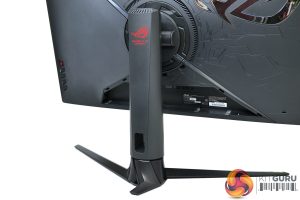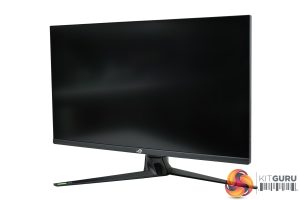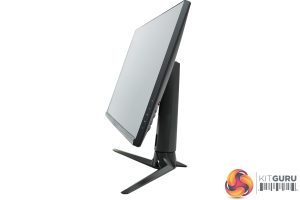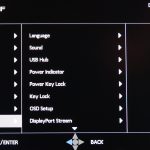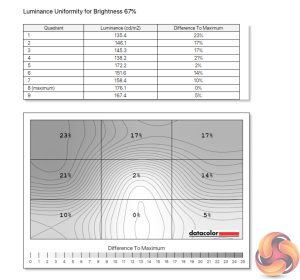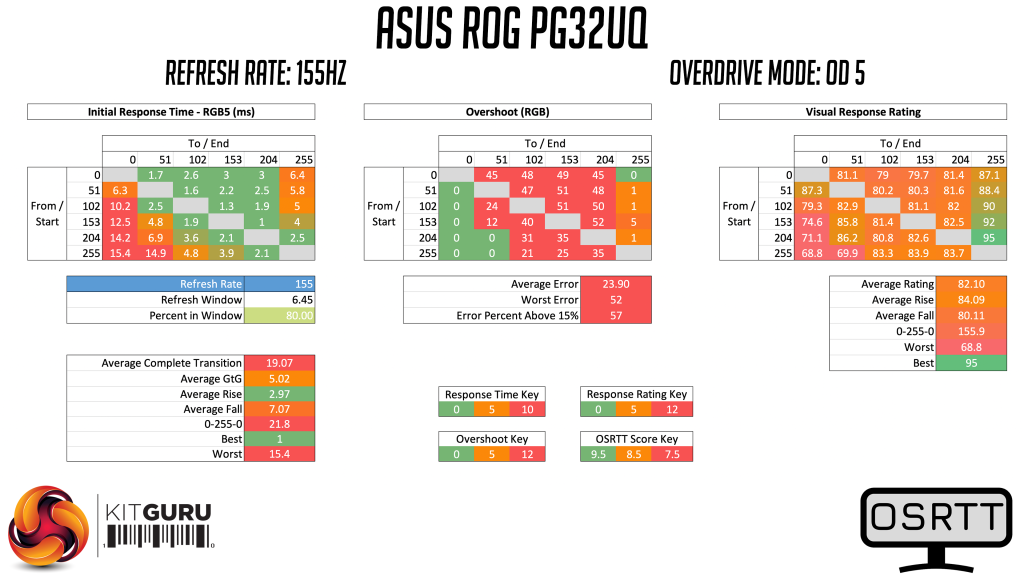
The ASUS ROG PG32UQX was one of the best monitors we reviewed in 2021. It wowed us with its sensational HDR performance, thanks to the use of over 1100 mini-LED zones. Such technology does not come cheap however, and the PG32UQX still retails for over £3200 today, making it viable for only the richest of enthusiasts. So what if you want something similar, but just can't afford to drop several thousand pounds? That's where the PG32UQ (non-X) comes in.
Offering the same 4K 144Hz IPS panel, but ditching the mini-LED zones in favour of a more basic edge-lit setup, the ASUS ROG PG32UQ is much more competitively priced at £849 here in the UK. Granted, it is by no means cheap, but its pricing puts it in line with other competitors offering the same resolution and refresh rate.
It still boasts HDR600 certification however, claimed 98% DCI-P3 coverage and official G-Sync Compatible certification, making it very appealing on paper. Let's find out what it is like to use in the real world.
Specification:
- Panel Size (inch): 32
- Aspect Ratio: 16:9
- Color Space (DCI-P3): 98%
- Color Space (sRGB): 160%
- Panel Type: IPS
- Panel Backlight: LED
- True Resolution: 3840×2160
- Display Viewing Area (HxV): 708.48 x 398.52 mm
- Display Surface: Non-Glare
- Pixel Pitch: 0.185mm
- Brightness (Typ.): 450cd/㎡
- Brightness (HDR, Peak): 600 cd/㎡
- Contrast Ratio: 1000:1
- Contrast Ratio (HDR, Max): 1,000,000:1
- Viewing Angle (CR≧10): 178°/ 178°
- Response Time: 1ms MPRT
- Display Colors: 1073.7M (10 bit)
- Flicker free: Yes
- HDR (High Dynamic Range) Support: HDR10
- Refresh Rate (max): 144Hz
- VRR Technology: G-SYNC® Compatible
- I/O Ports: DisplayPort 1.4 DSC x 1, HDMI (v2.1) x 2
- Earphone jack: Yes
- USB Hub: 2x USB 3.2 Gen 1 Type-A, USB 3.0 (Signal) x 1
- Speaker: Yes(5Wx2)
- Tilt: Yes (+20° ~ -5°)
- Swivel: Yes (+25° ~ -25°)
- Height Adjustment: 0~100mm
- VESA Wall Mounting: 100x100mm
- Lighting effect (Aura): Aura Sync
The core design of the ASUS ROG PG32UQ is almost identical to its more expensive sibling. In fact, the only differences here comes down to the styling, as the actually chassis of the monitor appears to be exactly the same. The PG32UQ just loses the copper and gold accents of the PG32UQX, and instead we have a more toned-down neutral colour scheme.
It still looks very much like a gaming monitor, especially when viewed from the back, with the big ASUS ROG logo illuminated by RGB LEDs, but from the front I don't mind this design at all.
The stand offers a decent selection of adjustability too. We find up to 100mm of height adjustment, swivel up to 25° in both directions, as well as tilt, from 25° upwards to 5° downwards. Just like the PG32UQX, there's no pivot or rotational ability here, but VESA 100 mounts are support if you have a custom stand or monitor arm.
One key benefit to the PG32UQ versus the PG32UQX comes in the form of its I/O. We find 1x DisplayPort 1.4, but crucially, there are two HDMI 2.1 ports – the PG32UQX was sadly limited to HDMI 2.0 connectivity, but this is now corrected with the PG32UQ. Alongside a 3.5mm audio jack, we can also note a two-port USB 3.2 Gen1 hub.
Lastly, the OSD is controlled with a small joystick, as well as four secondary buttons. These are located on the back right corner of the display (when viewed from the front).
The PG32UQ offers a fully functional and detailed OSD system, split into 8 main tabs: Gaming, Image, Color, Input Select, PIP/PBP Setup, Lighting Effect, MyFavorite, and System Setup…
Everything is laid out and clearly, I didn't notice any missing features, and in fact ASUS offers a ton of gaming-centric features – including on-screen crosshair, shadow boost, FPS counter and more.
My only real gripe with the system comes down to the secondary buttons that ASUS has positioned below the joystick. It's a very minor point, but ASUS has programmed these buttons to access user-configurable quick shortcuts, like brightness or input selection. That's not bad in itself, but I am used to flicking the joystick either up, down, left or right to access such shortcuts. With the PG32UQ, any press of the joystick, in any direction, brings up the quick access menu, and then you have to click one of the secondary buttons.
It would make more sense to me to ditch the buttons, and just map the difference shortcuts to a push of the joystick in a different direction, but it's hardly a big deal.
Our main test involves using a DataColor SpyderX Colorimeter to assess a display’s image quality. The device sits on top of the screen while the software generates colour tones and patterns, which it compares against predetermined values to work out how accurate the screen is.
The results show –
- A monitor’s maximum brightness in candelas or cd/m2 at various levels set in the OSD.
- A monitor’s contrast ratio at various brightness levels in the OSD.
- The brightness deviation across the panel.
- The black and white points.
- The colour accuracy, expressed as a Delta E ratio, with a result under 3 being fine for normal use, and under 2 being great for colour-accurate design work.
- The exact gamma levels, with a comparison against preset settings in the OSD.
We first run this test with the display in its default, out-of-the-box state, with all settings on default. We then calibrate the screen using the Spyder software and run the test again.
Pre-calibration
Kicking off with the PG32UQ's gamut testing, it's a very positive start. We see 100% sRGB and 100% AdobeRGB coverage, and then 95% reporting for the DCI-P3 colour space. That's a touch lower than ASUS' claimed 98% coverage, but still a very strong start for a gaming monitor.
Colour uniformity is a strong area too. We do see some deviation at maximum brightness, but at 75% at below uniformity is excellent across the panel.
As for luminance uniformity, there is some aberration here at lower brightness levels, particularly in that upper left corner, though this gets less obvious at higher brightness levels.
On the topic of brightness, we see a peak reading of 407 nits for the PG32UQ, a strong result. I typically found myself using the screen at 70%, so there's plenty of headroom for those in particularly bright environments. The minimum brightness value of 76 nits is less impressive however, I would like to see this go a bit lower.
The contrast figure is also quite lacklustre, reporting at 540:1. I've mentioned in a previous review the the SpyderX units can under-report contrast and I believe that is what is happening here. In any case, for an IPS panel contrast is never going to be the greatest.
More pleasing though is the perfect white point, hitting 6500K dead at both 75% and 100% brightness.
The PG32UQ offers three different gamma settings, and it's great to see the 2.2 setting delivering an exact gamma reading of 2.2. The 1.8 setting is also accurate, though strangely the other setting ASUS has included is meant to offer a gamma value of 2.5, but reports at 2.4 instead.
Out of the box colour accuracy is superb for the PG32UQ. We see an average deltaE of just 0.63, which is staggering, while only one of the 48 colour channels exceeds a deltaE of 2.
Post-calibration
Firing up the Spyder X to calibrate the screen, not much changes at all in terms of gamut, brightness or gamma. Colour accuracy sees a very small improvement however, with a new average deltaE of 0.55 – though I am not sure you would notice the difference between this and the uncalibrated state!
Monitor response time testing is a new addition to our reviews, where we use the Open Source Response Time Tool (OSRTT), developed by TechTeamGB. This measures grey-to-grey response times and presents the results in a series of heatmaps, the style of which you may be familiar with from other reviews.
Initial Response Time is the time taken for the panel to transition from one colour to another, where lower values are better. We present the initial response time, so overshoot is not taken into account and is measured separately. We use a fixed RGB 5 tolerance for each transition.
Overshoot is the term given for when a monitor's transition exceeds or goes beyond its target value. So if a monitor was meant to transition from RGB 0 to RGB 55, but it hits RGB 60 before settling back down at RGB 55, that is overshoot. This is presented as RGB values in the heatmaps – i.e. how many RGB values past the intended target were measured.
Visual Response Rating is a metric designed to ‘score' a panel's visual performance, incorporating both response times and overdrive. Fast response times with little to no overshoot will score well, while slow response times or those with significant overshoot will score poorly.
We test the PG32UQ at 155Hz, using all five of the overdrive settings found within the OSD.
The first three overdrive modes are not worth using in my opinion. All offer no, or next to no, overshoot, but with pretty slow response times. They do get slightly faster when comparing OD1 to OD3, the latter which reports an average GtG response time of 9.13ms, but that's still a lacklustre result.
OD 4 is the best mode in my view, though again it is still quite slow, with an average GtG response time of 8.65ms. The panel seems to have most trouble with its fall times, with the slowest response times shown when transitioning from pure white (RGB 255) shades, as you can see in the bottom left corner of the heatmap. There is again very little overshoot however, making this the most usable mode for me.
The reason I don't recommend OD5 mode is the excessive overshoot that is introduced. Grey-to-grey response times are much faster across the board, but at the cost of some excessive inverse ghosting, which was very unpleasant to look at.
This does mean there's not really an ideal overdrive mode to use – OD 4 is still a bit slow, while OD 5 just has far too much overshoot. Like I say, OD 4 is the best of the lot, but I'd have liked to see a setting between OD 4 and 5, as I think we could see faster response times but without the excessive overshoot introduced by OD 5 mode.
Putting the results into context, the PG32UQ sits towards the bottom of our chart, though we have plenty more monitors to test before this becomes a comprehensive comparison. We can see that the PG32UQ isn't miles slower than the MSI MPG321UR-QD however, which is a similar 32in 4K/144Hz display, but the Eve Spectrum is a class apart in terms of the response times.
System latency is another area of our testing, where we use Nvidia’s Latency and Display Analyzer Tool (LDAT) to measure end-to-end system latency. LDAT itself is a photosensor which is placed on the monitor. It has an integrated mouse button, allowing it to measure the total time taken from mouse click, to an action happening on screen, which is done by measuring a change in luminance. This data is logged to a CSV file over USB, allowing for close analysis of the data.
As this is end-to-end system latency, we are not measuring only the processing/input latency of each monitor we test. However, we can standardise the test process so the monitor is the only variable. It also gives an insight into how different refresh rates and resolutions can affect end-to-end latency, which is of course highly relevant to your purchasing decision.
We use Rainbow Six Siege for this testing.
Thankfully, latency is no problem for the PG32UQ, offering essentially the same click-to-fire times as the Eve Spectrum and AOC U28G2XU. The only screens we have tested that can do better are lower resolution and higher refresh-rate, so you're unlikely to get better latency from a 4K/144Hz display.
Almost a year on from our review of the ASUS ROG PG32UQX, today we have assessed the PG32UQ (non-X) model, designed to offer a 4K/144Hz gaming experience at a much more palatable price tag.
By ditching the mini-LED setup and hardware G-Sync module, ASUS has been able to offer the PG32UQ for £849, compared to an asking price of over three grand for the PG32UQX. Granted, that does mean the HDR experience is much less impressive, but if you want the core 4K/144Hz gaming experience and aren't too fussed about HDR, then you are saving a lot of cash with this lower-end model.
Of course, it's still not cheap so we would expect excellent image quality, and thankfully the PG32UQ delivers. It's gamut coverage, brightness levels and out of the box colour accuracy are all superb, and in fact this is one of the most colour-accurate displays I have ever tested – it barely improved at all once manually calibrated, as the factory calibration was so impressive.
The PG32UQ still boasts DisplayHDR600 certification too, so it's not like it's been completely neutered in that department. I would personally prefer to play in SDR however, as the 16 edge-lit dimming zones don't really do it for me, and I could visibly spot these LEDs changing in certain game scenarios which was a bit distracting.
The main weakness for this panel however, has to be the response times. Using the OD 4 mode, we saw relatively slow response times, but with very little overshoot. OD 5 was able to speed things up significantly, but that the cost of a lot of visible overshoot. I would have liked to see more fine-tuning here, as I am certain there could definitely be a better middle ground between those two modes – something a user-configurable overdrive setting would address (as we saw with the Eve Spectrum).
How much of a problem this will be for you does depend. If you're an ultra-competitive online gamer, you probably weren't considering a 4K panel to begin with, and for slower paced RPG-style games I don't think the slow response times matter as much. The only other 32in 4K/144Hz screen I've tested is the MSI MPG321UR-QD, and that isn't much faster at all.
If you can live with that, then the ASUS ROG PG32UQ is a very solid gaming monitor. It hasn't quite wowed me, but it's definitely a strong contender for your money if you are in the market for a larger, high refresh-rate 4K screen.
We found it on sale for £849 from Curry's HERE.
Discuss on our Facebook page HERE.
Pros
- 4K resolution, at 144Hz, looks great on the 32in panel.
- Seriously impressive out of the box colour accuracy.
- Gets nice and bright.
- Low latency.
- Official G-Sync Compatible certification.
- Two HMDI 2.1 ports.
- Less eccentric design than the PG32UQX.
Cons
- Not the fastest – user-configurable overdrive would have been a good addition here.
- Edge-lit dimming zones don't add much for HDR.
KitGuru says: It's a solid 4K/144Hz gaming monitor, we just would have liked to see more control of the overdrive settings to fine-tune the experience. At the moment, response times are a bit on the slow side.
 KitGuru KitGuru.net – Tech News | Hardware News | Hardware Reviews | IOS | Mobile | Gaming | Graphics Cards
KitGuru KitGuru.net – Tech News | Hardware News | Hardware Reviews | IOS | Mobile | Gaming | Graphics Cards




